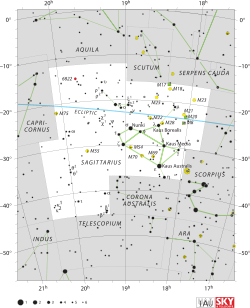Eta Sagittarii

Location of η Sagittarii (circled) | |
| Observation data Epoch J2000 Equinox J2000 | |
|---|---|
| Constellation | Sagittarius |
| Right ascension | 18h 17m 37.63505s[1] |
| Declination | −36° 45′ 42.0667″[1] |
| Apparent magnitude (V) | +3.11[2]/+7.8 |
| Characteristics | |
| Spectral type | M2 III[3] + F7 V[4] |
| U−B color index | +1.71[2] |
| B−V color index | +1.56[2] |
| Variable type | Irregular[5] |
| Astrometry | |
| Radial velocity (Rv) | +0.5[6] km/s |
| Proper motion (μ) | RA: −129.56[1] mas/yr Dec.: −166.26[1] mas/yr |
| Parallax (π) | 22.35 ± 0.24[1] mas |
| Distance | 146 ± 2 ly (44.7 ± 0.5 pc) |
| Absolute magnitude (MV) | −4.90[5] |
| Details | |
| η Sgr A | |
| Radius | 57[7] R☉ |
| Other designations | |
Eta Sagittarii (Eta Sgr, η Sagittarii, η Sgr) is a binary star system in the southern zodiac constellation of Sagittarius. Based upon parallax measurements, it is located at a distance of 146 light-years (45 parsecs) from Earth.[1] It was formerly known as "Beta Telescopii" (β Tel). In India, where part of the constellation of Sagittarius represents an Elephant, this star forms the creature's tail.[9]
The primary component, η Sagittarii A, is a red giant star with a stellar classification of M2 III.[3] It is an evolved star that is currently at a stage called the asymptotic giant branch, having exhausted both the hydrogen and the helium at its core.[10] This star is classified as an oxygen-rich irregular variable,[5] as it undergoes small magnitude fluctuations between +3.08 and 3.12.[4] The measured angular diameter of this star is 11.9 ± 2.1 mas.[11] At the estimated distance of Eta Draconis,[1] this yields a physical size of about 57 times the radius of the Sun.[7]
The companion, η Sagittarii B, was first noted by American astronomer S. W. Burnham in 1879. The two stars share a common proper motion and hence are probably gravitationally bound to each other.[12] The secondary is likely an F-type main sequence star with an apparent magnitude of +7.77. It located at an angular separation of 3.6 arcseconds from the primary, along a position angle of 108°.[13] This star is at a projected distance of 165 Astronomical Units from the red giant primary and the pair take a minimum of 1,270 years to complete an orbit.[4]
Within the context of the Milky Way galaxy, this system is a member of the faint old disk group.[5] Because of proper motion, this star will move into constellation Corona Australis around 6300 CE.[14] Eta Sagittarii has two optical companions that are not physically associated with the system. The first is a 10th magnitude star at an angular separation of 93 arcseconds with a position angle of 303°. There is a fainter, 13th magnitude star at an angular separation of 33 arcseconds along a position angle of 276°.[12]
Name and etymology
- This star, together with γ Sgr, δ Sgr and ε Sgr were Al Naʽām al Wārid (النعم الوارد), the Going Ostriches.[15] According to the catalogue of stars in the Technical Memorandum 33-507 - A Reduced Star Catalog Containing 537 Named Stars, Al Naʽām al Wārid or Namalwarid was the title for this star[16]
- In Chinese, 箕 (Jī), meaning Winnowing Basket, refers to an asterism consisting of η Sagittarii, γ Sagittarii, δ Sagittarii and ε Sagittarii. Consequently, η Sagittarii itself is known as 箕宿四 (Jī Sù sì, English: the Fourth Star of Winnowing Basket.)[17]
References
- ↑ 1.0 1.1 1.2 1.3 1.4 1.5 1.6 van Leeuwen, F. (November 2007), "Validation of the new Hipparcos reduction", Astronomy and Astrophysics 474 (2): 653–664, arXiv:0708.1752, Bibcode:2007A&A...474..653V, doi:10.1051/0004-6361:20078357.
- ↑ 2.0 2.1 2.2 Nicolet, B. (1978), "Photoelectric photometric Catalogue of homogeneous measurements in the UBV System", Astronomy and Astrophysics Supplement Series 34: 1–49, Bibcode:1978A&AS...34....1N.
- ↑ 3.0 3.1 Houk, Nancy (1979), Michigan catalogue of two-dimensional spectral types for the HD stars 3, Ann Arbor, Michigan: Dept. of Astronomy, University of Michigan, Bibcode:1982mcts.book.....H.
- ↑ 4.0 4.1 4.2 Kaler, James B., "Eta Sagittarii", Stars (University of Illinois), retrieved 2012-02-10.
- ↑ 5.0 5.1 5.2 5.3 Mennessier, M. O. et al. (August 2001), "Long period variable stars: galactic populations and infrared luminosity calibrations", Astronomy and Astrophysics 374: 968–979, arXiv:astro-ph/0105552, Bibcode:2001A&A...374..968M, doi:10.1051/0004-6361:20010764.
- ↑ Wilson, R. E. (1953), General Catalogue of Stellar Radial Velocities, Carnegie Institute of Washington D.C., Bibcode:1953GCRV..C......0W.
- ↑ 7.0 7.1 Lang, Kenneth R. (2006), Astrophysical formulae, Astronomy and astrophysics library 1 (3 ed.), Birkhäuser, ISBN 3-540-29692-1. The radius (R*) is given by:
- ↑ "HD 167618 -- Variable Star", SIMBAD Astronomical Database, retrieved 2007-03-29.
- ↑ O'Meara, Stephen James (2011), Deep-Sky Companions: The Secret Deep, Cambridge University Press, p. 341, ISBN 0-521-19876-3.
- ↑ Eggen, Olin J. (July 1992), "Asymptotic giant branch stars near the sun", Astronomical Journal 104 (1): 275–313, Bibcode:1992AJ....104..275E, doi:10.1086/116239.
- ↑ Richichi, A.; Percheron, I. (May 2005), "First results from the ESO VLTI calibrators program", Astronomy and Astrophysics 434 (3): 1201–1209, arXiv:astro-ph/0501532, Bibcode:2005A&A...434.1201R, doi:10.1051/0004-6361:20042257
- ↑ 12.0 12.1 Burnham, Robert (1978), Burnham's Celestial Handbook: an observer's guide to the universe beyond the solar system, Dover books explaining science 3 (2nd ed.), Courier Dover Publications, ISBN 0-486-23673-0.
- ↑ Jasinta, D. M. D.; Soegiartini, E. (October 1994), "Photographic observations of visual double stars", Astronomy and Astrophysics Supplement 107: 235–241, Bibcode:1994A&AS..107..235.
- ↑ Moore, Patrick; Rees, Robin (2011), Patrick Moore's Data Book of Astronomy, Cambridge: Cambridge University Press, p. 296.
- ↑ Allen, R. H. (1963). Star Names: Their Lore and Meaning (Reprint ed.). New York: Dover Publications Inc. p. 355. ISBN 0-486-21079-0. Retrieved 2012-09-04.
- ↑ Jack W. Rhoads - Technical Memorandum 33-507-A Reduced Star Catalog Containing 537 Named Stars, Jet Propulsion Laboratory, California Institute of Technology; November 15, 1971
- ↑ (Chinese) AEEA (Activities of Exhibition and Education in Astronomy) 天文教育資訊網 2006 年 5 月 11 日
| ||||||||||||||||||||||||||
